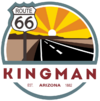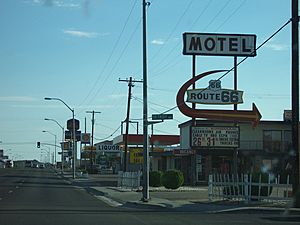Kingman, Arizona facts for kids
Quick facts for kids
Kingman, Arizona
|
||
|---|---|---|
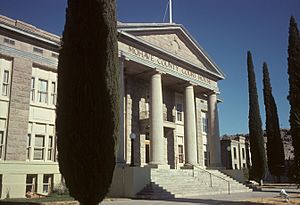
Mohave County Courthouse in Kingman
|
||
|
||
| Motto(s):
"The Heart of Historic Route 66"
|
||
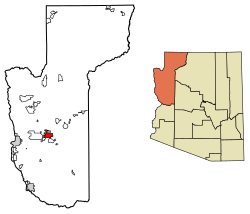
Location in Mohave County, Arizona
|
||
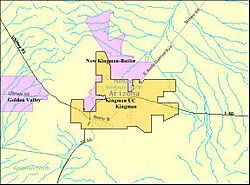
U.S. Census map
|
||
| Country | United States | |
| State | Arizona | |
| County | Mohave | |
| Incorporated | 1882 | |
| Area | ||
| • Total | 37.55 sq mi (97.25 km2) | |
| • Land | 37.55 sq mi (97.25 km2) | |
| • Water | 0.00 sq mi (0.00 km2) | |
| Elevation | 3,333 ft (1,016 m) | |
| Population
(2020)
|
||
| • Total | 32,689 | |
| • Density | 870.62/sq mi (336.14/km2) | |
| Time zone | UTC−7 (MST; Arizona Time (no DST)) | |
| ZIP codes |
86401, 86402, 86409
|
|
| Area code(s) | 928 | |
| FIPS code | 04-37620 | |
Kingman is a city in and the county seat of Mohave County, Arizona, United States. It is named after Lewis Kingman, an engineer for the Atlantic and Pacific Railroad. It is located 105 miles (169 km) southeast of Las Vegas, Nevada, and 180 miles (290 km) northwest of Arizona's state capital, Phoenix. The population was 32,689 at the 2020 census.
Contents
History
Lt. Edward Fitzgerald Beale, a U.S. Navy officer in the service of the Army Corps of Topographical Engineers, was ordered by the U.S. War Department to build a federal wagon road across the 35th parallel. His secondary orders were to test the feasibility of the use of camels as pack animals in the Southwestern desert. Beale traveled through the present-day Kingman in 1857 surveying the road and in 1859 to build the road. Beale's Wagon Road became part of U.S. Route 66 and later Interstate 40. Remnants of the wagon road can still be seen in White Cliffs Canyon in Kingman.
Kingman was founded in 1882 before statehood, in Arizona Territory. Situated in the Hualapai Valley between the Cerbat and Hualapai mountain ranges, Kingman had its modest beginnings as a simple railroad siding near Beale Springs. Civil engineer Lewis Kingman supervised the building of the railroad from Winslow to Beale Springs. This spring had been used by Native Americans living in the area for centuries.
The Mohave County seat was originally located in Mohave City from 1864 to 1867. In 1865, the portion of Arizona Territory west of the Colorado River was transferred to Nevada after Nevada's statehood, and became part of Lincoln County, now Clark County, Nevada. The remaining territory of Pah-Ute County became part of Mohave County. Its seat was moved to Hardyville (now within Bullhead City) in 1867. The county seat transferred to the mining town of Cerbat in 1873, then to Mineral Park near Chloride. After some time, the county seat and all instruments were permanently moved to Kingman in 1887.
During World War II, Kingman was the site of a U.S. Army Air Force (USAAF) airfield. The Kingman Army Airfield was founded at the beginning of the war as an aerial gunnery training base. It became one of the USAAF's largest, training some 35,000 soldiers and airmen. The airfield and Kingman played a significant role in this important era of America's history. Following the war, the Kingman Airfield was one of the largest reclamation sites for obsolete military aircraft.
Postwar, Kingman experienced growth as several major employers moved into the vicinity. In 1953, Kingman was used to detain those men accused of practicing polygamy in the Short Creek raid, which was at the time one of the largest arrests in American history. In 1955, Ford Motor Company established a proving ground (now one of the Chrysler Proving Grounds) in nearby Yucca at the former Yucca Army Airfield. Several major new neighborhoods in Kingman were developed to house the skilled workers and professionals employed at the proving ground. Likewise, the development of the Mineral Park mine near adjacent Chloride, and construction of the Mohave Generating Station in nearby Laughlin, Nevada, in 1971 contributed to Kingman's population growth. Also, the location of a General Cable plant at the Kingman Airport Industrial Park provided steady employment.
Kingman explosion
The Kingman Explosion, also known as the Doxol Disaster or Kingman BLEVE, was a catastrophic boiling liquid expanding vapor explosion (BLEVE) that occurred on July 5, 1973, during a propane transfer from a Doxol railroad car to a storage tank on the Getz rail siding near Andy Devine Avenue/Route 66.
Firefighters Memorial Park in Kingman is dedicated to the 11 firefighters who died in the blaze.
1980s and on
The 1915-built Mohave County Courthouse and 1909-built Jail were listed on the National Register of Historic Places in 1983. The downtown and other areas of Kingman were evaluated for historic resources in a 1985 study, the Kingman Multiple Resources Area study. The study identified 63 historic resources in Kingman and led to many of them being listed on the National Register of Historic Places in 1986. The county courthouse and jail, a 1928-built locomotive (the Santa Fe 3759), a World War II gunnery school radio tower, and about 50 various houses and other buildings in Kingman are listed on the National Register, comprising the majority of National Register listings in Mohave County.
Geography
Kingman is in central Mohave County, along Interstate 40 and U.S. Route 93. The city is served by three exits on I-40, which leads east 147 miles (237 km) to Flagstaff and southwest 62 miles (100 km) to Needles, California. US-93 leads northwest 107 miles (172 km) to Las Vegas and southeast 130 miles (210 km) to Wickenburg, 54 miles (87 km) from Phoenix. US 93 is planned to be replaced by Interstate 11 once built to interstate highway standards. According to the United States Census Bureau, the city of Kingman has a total area of 37.5 square miles (97 km2), all land.
Climate
Kingman sits on the eastern edge of the Mojave Desert, but it is located in a cold desert climate (Köppen BWk) due to its plateau location. Kingman's higher elevation and location between the Colorado Plateau and the Lower Colorado River Valley keeps summer high temperatures away from the extremes (115 °F (46 °C) or more) experienced by Phoenix and the Colorado River Valley. The higher elevation also contributes to winter cold and occasional snowfall. Summer daytime highs reach above 90 °F (32 °C) frequently, but rarely exceed 107 °F (42 °C). Summertime lows usually remain between 60 and 70 °F (16 and 21 °C). Winter highs are generally mild, ranging from around 50 to 60 °F (10 to 16 °C), but winter nighttime lows often fall to freezing, with significantly lower temperatures possible, and occasional snow.
The record low temperature in Kingman was set on January 9, 1937, at 6 °F (−14 °C), and the record high temperature occurred on July 15, 2023, at 114 °F (46 °C). The wettest year was 1919 with 21.22 inches (539 mm) and the driest year was 1947 with 3.58 inches (91 mm). The most rainfall in one month was 9.85 inches (250 mm) in September 1939. The most rainfall in 24 hours was 6.03 inches (153 mm) on November 28, 1919. The snowiest year was 1949 with 18.2 inches (0.46 m). The most snowfall in one month was 14.0 inches (0.36 m) in December 1932. On December 31, 2014, and January 1, 2015, Kingman received 6.5 inches of snow. The storm was so significant that it was a contributing factor for closing Interstate 40 at the US 93 Junction for 24 hours.
| Climate data for Kingman, Arizona, 1991–2020 normals, extremes 1901–present | |||||||||||||
|---|---|---|---|---|---|---|---|---|---|---|---|---|---|
| Month | Jan | Feb | Mar | Apr | May | Jun | Jul | Aug | Sep | Oct | Nov | Dec | Year |
| Record high °F (°C) | 78 (26) |
82 (28) |
90 (32) |
97 (36) |
106 (41) |
113 (45) |
114 (46) |
111 (44) |
110 (43) |
102 (39) |
90 (32) |
77 (25) |
114 (46) |
| Mean maximum °F (°C) | 68.6 (20.3) |
72.9 (22.7) |
80.7 (27.1) |
89.9 (32.2) |
96.7 (35.9) |
105.3 (40.7) |
107.7 (42.1) |
105.1 (40.6) |
100.8 (38.2) |
90.5 (32.5) |
81.8 (27.7) |
69.7 (20.9) |
108.9 (42.7) |
| Mean daily maximum °F (°C) | 57.4 (14.1) |
60.6 (15.9) |
67.4 (19.7) |
74.8 (23.8) |
84.9 (29.4) |
95.1 (35.1) |
98.7 (37.1) |
97.2 (36.2) |
90.9 (32.7) |
78.9 (26.1) |
66.1 (18.9) |
55.7 (13.2) |
77.3 (25.2) |
| Daily mean °F (°C) | 44.2 (6.8) |
47.0 (8.3) |
52.7 (11.5) |
59.1 (15.1) |
68.8 (20.4) |
78.7 (25.9) |
84.3 (29.1) |
83.1 (28.4) |
75.6 (24.2) |
63.6 (17.6) |
51.3 (10.7) |
42.9 (6.1) |
62.6 (17.0) |
| Mean daily minimum °F (°C) | 30.9 (−0.6) |
33.3 (0.7) |
38.1 (3.4) |
43.4 (6.3) |
52.7 (11.5) |
62.3 (16.8) |
70.0 (21.1) |
68.9 (20.5) |
60.4 (15.8) |
48.3 (9.1) |
36.5 (2.5) |
30.2 (−1.0) |
47.9 (8.8) |
| Mean minimum °F (°C) | 18.5 (−7.5) |
20.9 (−6.2) |
27.1 (−2.7) |
31.3 (−0.4) |
39.4 (4.1) |
50.4 (10.2) |
62.7 (17.1) |
60.1 (15.6) |
48.0 (8.9) |
35.1 (1.7) |
24.5 (−4.2) |
19.5 (−6.9) |
15.7 (−9.1) |
| Record low °F (°C) | 4 (−16) |
9 (−13) |
11 (−12) |
20 (−7) |
29 (−2) |
34 (1) |
45 (7) |
43 (6) |
31 (−1) |
23 (−5) |
13 (−11) |
6 (−14) |
4 (−16) |
| Average precipitation inches (mm) | 0.98 (25) |
1.04 (26) |
0.59 (15) |
0.46 (12) |
0.08 (2.0) |
0.11 (2.8) |
0.86 (22) |
0.88 (22) |
0.96 (24) |
0.74 (19) |
0.62 (16) |
0.68 (17) |
8.00 (203) |
| Average precipitation days (≥ 0.01 inch) | 4.0 | 4.7 | 3.4 | 2.9 | 1.2 | 0.8 | 5.3 | 4.9 | 3.7 | 3.0 | 2.4 | 3.8 | 40.1 |
| Source: NOAA (mean maxima/minima 2006–2020) | |||||||||||||
Demographics
| Historical population | |||
|---|---|---|---|
| Census | Pop. | %± | |
| 1890 | 322 | — | |
| 1910 | 900 | — | |
| 1920 | 1,276 | 41.8% | |
| 1930 | 2,275 | 78.3% | |
| 1950 | 3,342 | — | |
| 1960 | 4,525 | 35.4% | |
| 1970 | 7,312 | 61.6% | |
| 1980 | 9,257 | 26.6% | |
| 1990 | 12,722 | 37.4% | |
| 2000 | 20,069 | 57.8% | |
| 2010 | 28,068 | 39.9% | |
| 2020 | 32,689 | 16.5% | |
| U.S. Decennial Census | |||
2022 American Community Survey
As of 2022[update] American Community Survey estimates, there were 33,052 people and 14,029 households. The population density was 880.3 inhabitants per square mile (339.9/km2). There were 14,929 housing units at an average density of 397.6 per square mile (153.5/km2). The racial makeup of the city was 85.2% White, 2.9% some other race, 2.0% Black or African American, 1.6% Asian, and 1.0% Native American or Alaskan Native, with 7.4% from two or more races. Hispanics or Latinos of any race were 16.6% of the population.
Of the 14,029 households, 27.4% had children under the age of 18 living with them, 40.1% had seniors 65 years or older living with them, 43.9% were married couples living together, 7.8% were couples cohabitating, 20.3% had a male householder with no partner present, and 27.9% had a female householder with no partner present. The median household size was 2.25 and the median family size was 2.77.
The age distribution was 21.1% under 18, 6.6% from 18 to 24, 25.2% from 25 to 44, 23.1% from 45 to 64, and 24.1% who were 65 or older. The median age was 42.1 years. For every 100 females, there were 99.9 males.
The median income for a household was $56,360, with family households having a median income of $63,614 and non-family households $34,468. The per capita income was $31,806. Out of the 31,655 people with a determined poverty status, 13.4% were below the poverty line. Further, 18.7% of minors and 9.4% of seniors were below the poverty line.
In the survey, residents self-identified with various ethnic ancestries. People of German descent made up 17.8% of the population of the town, followed by English at 13.3%, Irish at 10.5%, American at 5.2%, Italian at 4.9%, French at 3.5%, Polish at 2.5%, Norwegian at 2.4%, Dutch at 1.8%, Scottish at 1.7%, Swedish at 1.2%, Russian at 1.0%, Scotch-Irish at 1.0%, Welsh at 0.9%, Portuguese at 0.6%, French Canadian at 0.5%, and Hungarian at 0.5%.
2020 census
At the 2020 census, there were 32,689 people.
2010 census
At the 2010 census, there were 28,068 people.
Economy
Top employers
According to Kingman's 2019 Comprehensive Annual Financial Report, the top employers in the city are:
| # | Employer | # of employees |
|---|---|---|
| 1 | Kingman Regional Medical Center | 1,800 |
| 2 | Mohave County | 1,271 |
| 3 | Kingman Unified School District | 740 |
| 4 | Mohave Community College | 700 |
| 5 | American Woodmark | 689 |
| 6 | Walmart | 440 |
| 7 | City of Kingman | 374 |
| 8 | Laron Inc | 187 |
| 9 | The Home Depot | 135 |
| 10 | Indiana Western Express, Inc. | 119 |
Infrastructure
Transportation
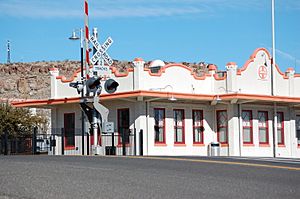
Major highways
 Interstate 40
Interstate 40 U.S. Route 93
U.S. Route 93 Arizona State Route 66
Arizona State Route 66 Business Loop 40 and Arizona SR 66 are composed of the remnants of what was
Business Loop 40 and Arizona SR 66 are composed of the remnants of what was  U.S. Route 66.
U.S. Route 66. Arizona State Route 68
Arizona State Route 68 Interstate 11 is proposed to replace U.S. Route 93.
Interstate 11 is proposed to replace U.S. Route 93.
Airport
The Kingman Airport is located 9 miles (14 km) northeast of Kingman on Arizona State Route 66. The airport was originally built as Kingman Army Air Field during World War II and was the location of the Kingman Aerial Gunnery School. The airport was turned over to Mohave County for civilian use in 1949. There are air ambulance and air charter services, but no commercial flights. The closest commercial airport is Harry Reid International Airport in Paradise, Nevada, approximately 104 miles (167 km) northwest of Kingman. The Kingman airport now primarily exists as a location for long-term aircraft storage due to its suitable large ramp space and a long, decommissioned runway. Kingman is a non-towered airport.
Rail
Located downtown, the Kingman station has daily services on Amtrak's Amtrak Southwest Chief between Los Angeles and Chicago. The historically significant station is constructed in Mission Revival style. Prior to the establishment of Amtrak in 1971, the building had fallen into disrepair. A total renovation was completed in 2010. The station houses a model railroad museum. Amtrak Thruway offers connecting service to Las Vegas.
Kingman is located on the Southern Transcon route of the BNSF Railway which is the main transcontinental route between Los Angeles and Chicago, which carries approximately 100 to 150 freight trains per day.
In August 2012, the Kingman Terminal Railroad (KGTR) opened at the Kingman Airport Authority and Industrial Park. The KGTR is a short line railroad owned by Patriot Rail. Patriot Rail owns and operates 13 railroads in 13 states across the U.S. The KGTR interchanges with BNSF and delivers to businesses at the industrial park.
Buses and shuttles
The City of Kingman operates Kingman Area Regional Transit. Kingman is served by the intercity bus companies Greyhound and TUFESA. FlixBus boards from a stop at 915 W Beale St. Tri-State Shuttle connects Kingman with Harry Reid International Airport in Paradise.
Amtrak Thruway is Kingman station bus service that travels to Las Vegas's stations at South Strip Transit Terminal, Airport Terminal One and Las Vegas downtown, called the Amtrak Kingman-Las Vegas Thruway Motorcoach, a 107 miles (172 km) trip. There is also a Laughlin to Kingman Amtrak Station at the Tropicana Laughlin in Laughlin, Nevada, a 34-mile (55 km) trip.
Water
The water system uses groundwater. The same aquifer serving the city is used by the industrial agriculture in the surrounding desert.
Education
Kingman has one public school district, one charter school district and one Christian school.
Public schools
Kingman Unified School District (KUSD) consists of 12 schools, ranging from Kindergarten to high school.
Elementary schools
- Hualapai Elementary School
- Cerbat Elementary School
- Palo Christi Elementary School (closed)
- Black Mountain Elementary School (located in the neighboring town of Golden Valley)
- La Senita Elementary School
- Manzanita Elementary School
- Desert Willow Elementary School
- Kingman Academy of Learning Primary/Intermediate School
Middle schools
- Golden Valley Middle School
- Kingman Middle School
- White Cliffs Middle School
- Kingman Academy of Learning Middle School
High schools
- Kingman High School
- Lee Williams High School
- Kingman Academy of Learning High School
K–12
- Mt. Tipton School, a KUSD K–12 school, is located in Dolan Springs, approximately 30 miles northwest of Kingman.
Other schools
- The Kingman Academy of Learning, a charter school, is split into four schools: a primary (pre-school – 2nd grade), intermediate (3–5), middle (6–8), and high school (9–12).
- The Emmanuel Christian Academy teaches students from kindergarten to 8th grade.
- Arizona Virtual Academy is a (K–12) Blended learning center.
Post-secondary education
- One of four main campuses, Mohave Community College, a junior college, is located in Kingman.
- Northern Arizona University has an extension campus located in Kingman.
Notable people
- Andy Devine (1905–1977), actor, was raised in Kingman, where his father opened the Beale Hotel. One of the major streets of Kingman is named "Andy Devine Avenue" and the town holds the annual "Andy Devine Days".
- Carlos Elmer (1920–1993), writer and photographer, was raised in Kingman. He was awarded a Lifetime Achievement Award by the Kingman Area Chamber of Commerce, and the city hosts the annual Carlos Elmer Photography Contest.
- Michael Fortier, Timothy McVeigh's co-conspirator, lived in Kingman from the age of seven.
- Doris Hill (1905–1976), born Roberta M. Hill, was an American film actress of the 1920s and 1930s.
- Paul Kalanithi (1977–2015), neurosurgeon and writer, was raised in Kingman.
- Timothy McVeigh (1968–2001), who carried out the Oklahoma City bombing, was a resident of Kingman for various periods between 1993 and 1995.
- Doug Mirabelli, former Boston Red Sox catcher, was born in Kingman.
- Aron Ra, atheist activist, regional director of American Atheists, and public speaker, was born in Kingman.
- Joseph Rosenberg, bank executive, worked as a banker in Kingman before moving to Los Angeles. Rosenberg was later Walt Disney's banker.
- Tarik Skubal, MLB pitcher for the Detroit Tigers
- Karen Steele, actress, lived and died in Kingman.
Points of interest
- Hualapai Mountain Recreation Area, 12 miles (19 km) to the southeast of Kingman
- Oatman, a "ghost town" tourist attraction 28 miles (45 km) southwest of Kingman
See also
 In Spanish: Kingman (Arizona) para niños
In Spanish: Kingman (Arizona) para niños


